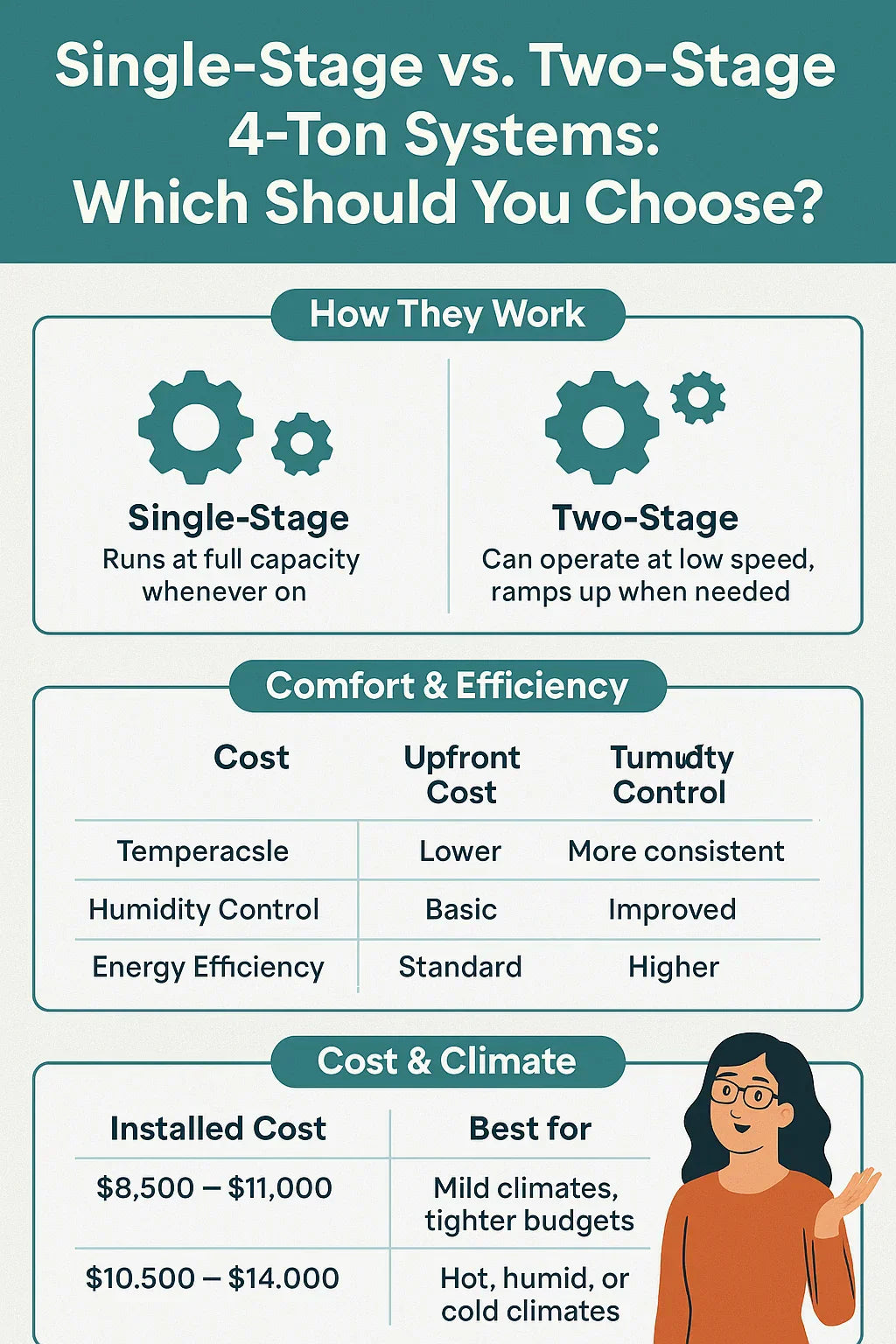1. Introduction – Why Staging Matters for Your Comfort
Hey there — Savvy here.
If you’re shopping for a 4-ton air conditioner and furnace combo, you’ve probably noticed something in the specs: single-stage or two-stage. And you may be wondering:
“Is two-stage just marketing hype, or is it actually worth the extra cost?”
The truth is, staging is one of the biggest factors in how comfortable and energy-efficient your home feels day in and day out.
Think of it like the gears in a car:
-
Single-stage: One gear — all or nothing.
-
Two-stage: Two gears — a lower gear for cruising, higher gear for extra power.
In this guide, we’ll walk through:
-
How single-stage and two-stage systems work
-
Comfort, efficiency, and humidity control differences
-
Costs, lifespan, and maintenance
-
Real homeowner examples
-
Savvy’s final checklist for choosing
By the end, you’ll know exactly which is right for your home — and your budget.
2. How Staging Works in 4-Ton Systems
Single-Stage Operation
A single-stage system is either ON at full blast or OFF.
When your thermostat calls for heating or cooling:
-
The system kicks on at 100% capacity.
-
It runs until the thermostat setting is reached.
-
It shuts off completely.
This means you get quick bursts of heating or cooling, but also more noticeable temperature swings.
Two-Stage Operation
A two-stage system has two capacity levels:
-
Low stage: ~60–70% of full capacity
-
High stage: 100% capacity
Most of the time, the system runs in low stage — delivering gentle, steady heating or cooling. When temperatures spike or drop dramatically, it switches to high stage for extra power.
Savvy analogy: Imagine pedaling a bike. Single-stage is like standing up and pushing hard with every pedal — then coasting. Two-stage is like pedaling smoothly most of the time, with an occasional sprint.
3. Pros & Cons of Single-Stage Systems
Pros
-
Lower upfront cost: Usually $1,500–$3,000 cheaper than two-stage.
-
Simpler mechanics: Fewer parts = less that can break.
-
Works fine in mild climates: Where extreme temps are rare, you won’t miss staging.
Cons
-
Less precise temperature control: Can overshoot the set temp before shutting off.
-
Humidity control: Shorter run times mean less moisture removal in cooling mode.
-
Energy use: Always running at full power uses more energy in moderate weather.
4. Pros & Cons of Two-Stage Systems
Pros
-
Better comfort: Fewer hot/cold swings.
-
Improved humidity control: Longer run times pull more moisture out of the air.
-
Quieter operation: Low stage runs with less fan noise.
-
Potential energy savings: Especially in climates with long shoulder seasons.
Cons
-
Higher upfront cost: $1,500–$3,000 more than single-stage.
-
More complex: Slightly more parts that could need repair.
-
Payback depends on climate: Savings are smaller in very hot or cold regions where high stage is used most.
5. Efficiency Ratings & Energy Use
Staging can impact SEER2 (cooling efficiency) and AFUE (heating efficiency) in real-world use.
| System Type | Typical SEER2 | Typical AFUE |
|---|---|---|
| Single-Stage | 14–16 | 80–92% |
| Two-Stage | 16–18+ | 90–98% |
Example – 2,000 sq. ft. home in Georgia:
-
Single-stage 15 SEER2 AC: ~$1,050/year in cooling costs
-
Two-stage 17 SEER2 AC: ~$925/year in cooling costs
-
Annual savings: ~$125 — but better comfort and humidity control year-round.
6. Climate Considerations
Hot & Humid Climates (Florida, Gulf Coast):
-
Two-stage ACs shine here — longer cycles = better humidity control.
-
Prevents the “cold but clammy” feeling from short cycling.
Cold Climates (Minnesota, New York):
-
Two-stage furnaces keep a more even temperature in winter.
-
Less temperature overshoot and fewer blasts of hot air.
Mild Climates (Oregon, Northern California):
-
Single-stage may be fine — staging’s comfort benefits are less noticeable.
7. Cost Comparison (2025)
Single-Stage 4-Ton AC + Furnace
-
Budget: $8,500 – $9,500 (14 SEER2, 80% AFUE)
-
Mid-range: $9,500 – $11,000 (15–16 SEER2, 90–92% AFUE)
Two-Stage 4-Ton AC + Furnace
-
Mid-range: $10,500 – $12,500 (16–17 SEER2, 92% AFUE)
-
High-end: $12,500 – $14,000 (18+ SEER2, 95–98% AFUE)
Savvy tip: The cost gap often narrows if you’re already upgrading to higher efficiency — many high-SEER2 models are two-stage by default.
8. Maintenance & Lifespan
Single-Stage
-
Lifespan: 15–20 years
-
Maintenance: Annual check-ups for cleaning and tuning
-
Repairs: Usually less expensive
Two-Stage
-
Lifespan: 15–20 years (with proper care)
-
Maintenance: Similar schedule, but parts can be pricier if repairs are needed
-
Repairs: More electronics, staging controls to maintain
9. Savvy’s Real-World Scenarios
Family in Texas (Two-Stage Win)
Maria’s home in Dallas had major humidity issues in summer. After switching to a two-stage 4-ton AC + 96% AFUE furnace, her home stayed cooler, drier, and her summer electric bill dropped $20–$30/month.
Retiree in Oregon (Single-Stage Smart Choice)
Jim replaced his old furnace and AC with a single-stage 15 SEER2 AC + 90% AFUE furnace. Mild winters and summers meant staging benefits were minimal — and he saved $2,500 upfront.
10. How to Decide Which Is Right for You
Ask yourself:
-
Climate – Do you have long, humid summers or long, cold winters? Go two-stage.
-
Budget – Can you invest $1,500–$3,000 more for comfort and potential savings?
-
Comfort Preferences – Do temperature swings bother you?
-
Humidity Control Needs – Does your home feel muggy in summer?
Savvy’s Rule of Thumb:
-
Two-Stage: Best for comfort-focused homeowners in variable or humid climates.
-
Single-Stage: Best for budget-conscious buyers in mild climates.
12. External Verified Sources
In the Next topic we will read more about: How to Maintain Your 4-Ton AC + Furnace for Peak Performance







